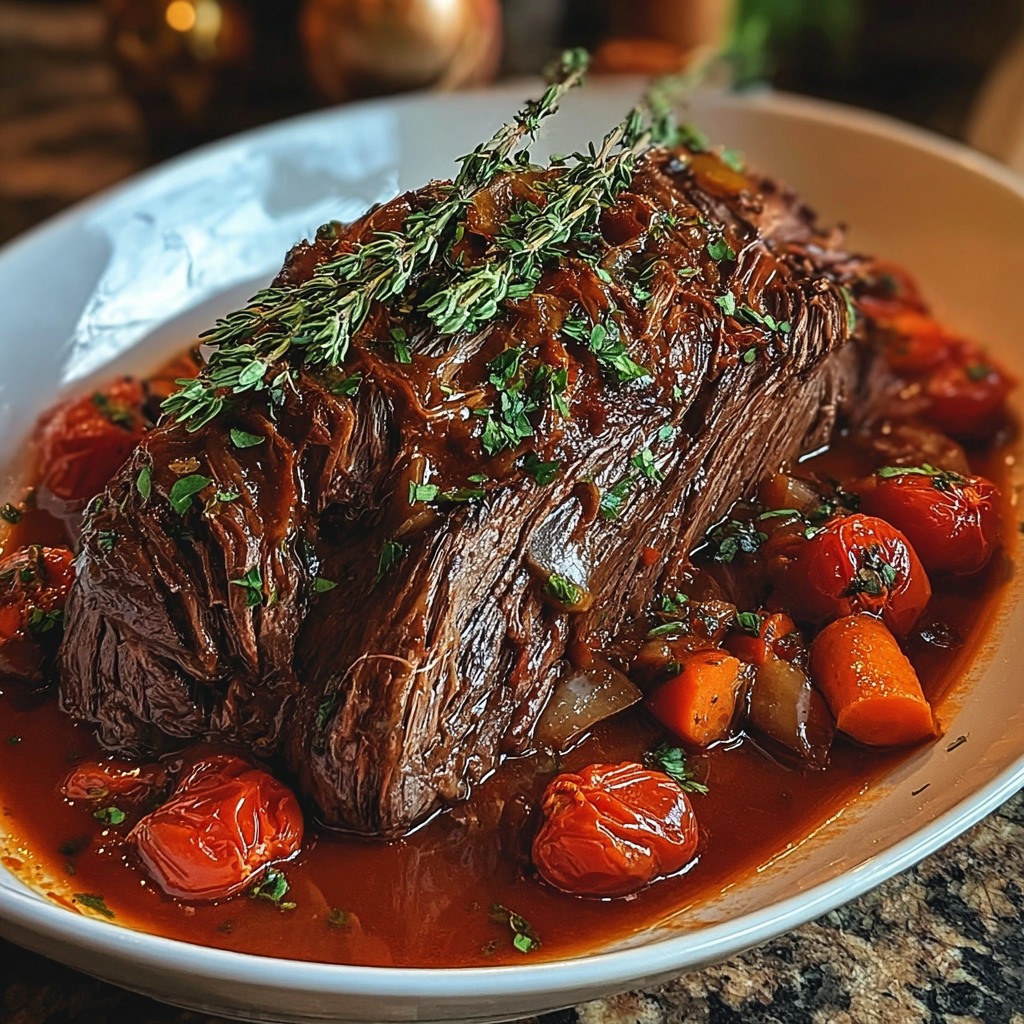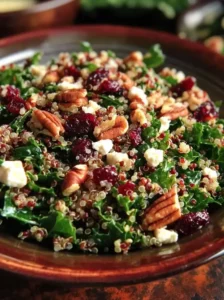Tuscan-Style Slow-Cooked Beef Roast: A Hearty Italian Delight
Imagine the rich aroma filling your kitchen as you prepare this Tuscan-Style Slow-Cooked Beef Roast. This robust, flavorful dish captures the essence of Italian cuisine, combining tender beef with a symphony of herbs and vegetables that meld together during slow cooking. Ideal for weekend family meals or a cozy dinner party, this beef roast not only appeals to the palate but also warms the soul.
Derived from Italy’s culinary heartland, this dish showcases top-quality beef slowly simmered with garlic, rosemary, and red wine until it reaches a melt-in-the-mouth perfection. The slow-cooking process ensures that every bite is infused with warmth and savory notes, transforming simple ingredients into a sumptuous feast. From the first whiff to the last bite, a Tuscan-style beef roast is a testament to the beauty of patience and traditional Italian cooking.
Quick Recipe Highlights
- Flavor Profile: A harmonious blend of rich beefiness, aromatic herbs, and a hint of red wine.
- Texture: The beef becomes exceptionally tender, with vegetables soften to perfection.
- Aroma: Savory notes of garlic and rosemary punctuated by the subtle earthiness of slow-cooked beef.
- Visual Appeal: A wholesome, rustic presentation with vibrant vegetables drenched in a rich sauce.
- Skill Level Needed: Moderate level, suitable for those comfortable with basic cooking techniques.
- Special Equipment: A slow cooker or a heavy-based pot suitable for long cooking.
Recipe Overview
- Difficulty Level: Moderate. Requires some basic skills in preparation and patience for the slow-cooking process to achieve the desired tenderness.
- Category: Main Course, ideal for dinners, especially during cooler months when hearty meals are appreciated.
- Cuisine: Italian-inspired, showcasing Tuscany’s love for quality ingredients and traditional techniques.
- Cost: Moderate, with the main expense being a quality cut of beef and fresh herbs.
- Season: Best enjoyed in autumn and winter, aligning with its deep, comforting flavors.
- Occasion: Perfect for family gatherings, festive dinners, or Sunday roasts.
Why You’ll Love This Recipe
The Tuscan-Style Slow-Cooked Beef Roast is a delight for the senses, boasting flavors that are both rich and nuanced. The tender beef effortlessly melts in the mouth, while the medley of herbs, wine, and garlic provide a delightful depth that satisfies all taste buds. Introduce your family to the art of slow cooking, offering them a dish where patience truly pays off with enhanced flavors.
Convenience is key with this recipe, as it requires minimal active cooking time. Once the initial preparation is done, the slow cooker takes care of the rest, allowing you to attend to other matters while your kitchen fills with the inviting aroma of this classic dish. It’s perfect for those seeking a hands-off approach while still delivering an exquisitely cooked meal.
Nutritionally, this dish offers a balanced meal rich in protein and essential vitamins from the accompanying vegetables. It’s a perfect comfort food that’s also nutritious, offering a meal that’s both satisfying and relatively wholesome, with room for gluten- or dairy-free adaptations if required.
With its roots in rich Italian tradition, this roast has a social component, ideal for sharing at dinner parties or family gatherings. It offers a sense of togetherness as everyone gathers around to enjoy a meal that’s been lovingly prepared over hours.
Economic value also follows this recipe, as it allows for using a more affordable cut of meat made tender through slow cooking. This makes it an accessible choice without compromising on taste, perfect for delighting guests or family on a budget.
Historical Background and Cultural Significance
The Tuscan-Style Slow-Cooked Beef Roast captures the essence of traditional Italian cooking, steeped in history and cultural significance. This dish finds its origins in Tuscany, a region renowned for its culinary richness and dedication to rustic, hearty flavors that reflect the pastoral landscape.
In Italian culture, meals are a communal activity, offering more than sustenance – it’s a time for connection. Historically, families would gather to prepare this roast during harvest festivals, symbolizing abundance and sharing. The slow-cooked methodology reflects a time when families relied on hearth-based cooking, allowing flavors to develop fully.
Over time, the evolution of this dish has introduced regional variations, incorporating local ingredients but always preserving the essential slow-cook technique. These adaptations demonstrate Italy’s culinary diversity while adhering to traditional principles. Regional twists might include the addition of local wines or seasonal vegetables unique to the area.
Today, the Tuscan-Style Beef Roast remains a staple in Italian households, celebrated for its ability to transform simple ingredients into a transcendent culinary experience. This dish not only honors the past but also embraces modern touches, ensuring its place on contemporary tables worldwide.
Ingredient Deep Dive
For the main ingredient, beef is key to achieving an authentic Tuscan roast. Historically considered a prized protein in Italian cuisine, beef provides a rich foundation. Nutritionally, it’s a good source of protein, iron, and vitamin B12, crucial for developing a balanced meal.
When selecting beef for your roast, opt for cuts like chuck or brisket, known for their flavor and tenderness when slow-cooked. These cuts are relatively marbled, which breaks down over long cooking times, imparting succulence and depth.
Storage-wise, keep the beef refrigerated until use, ensuring it is securely wrapped to prevent moisture loss. For extended storage, consider freezing, but ensure it’s defrosted slowly in a refrigerator before cooking to maintain quality. If you’re without beef or prefer alternatives, pork shoulder or lamb can serve as delicious substitutions, offering their distinctive flavors while providing a similar cooking experience.
Common Mistakes to Avoid
- Not searing the beef before slow cooking – this step is crucial for developing flavor and caramelizing the meat.
- Using low-quality wine – always use a wine you would enjoy drinking, as its flavor intensifies during cooking.
- Overcrowding the pot – leave room for heat circulation to ensure even cooking.
- Skipping the herbs – fresh herbs provide authenticity and depth; dried won’t replicate this effect.
- Not checking for doneness – test the beef’s tenderness with a fork; it should easily shred.
- Ignoring seasoning – don’t shy away from salt and pepper; they enhance overall taste.
- Cooking on high heat – slow cooking is key to achieving the melt-in-the-mouth texture.
- Adding too much liquid – only a little wine or broth is needed, as the beef will release its juices.
Essential Techniques
Master the art of searing to elevate your Tuscan-Style Slow-Cooked Beef Roast. Searing the beef before slow cooking locks in juices and helps develop a rich crust. Make sure your pan is hot enough; a good sear will produce a browning effect, adding both flavor and visual appeal. Avoid moving the beef too early; wait until it’s released naturally from the pan, an indicator that it’s perfectly seared.
Control of liquid balance during cooking ensures the right consistency. While it’s tempting to add more liquid, remember that slow cooking intensifies flavors, and the beef will contribute moisture as it cooks. The goal is a sauce that complements rather than overwhelms.
Another key technique is correctly layering flavors. The sequence in which you add ingredients affects the final taste. Start with aromatics like garlic and onion, adding complexity, and finish with fresh herbs to retain their delicate flavors. This layering is vital to achieving a symphonic result where each element is distinguishable yet harmonious.
Pro Tips for Perfect Tuscan-Style Slow-Cooked Beef Roast
To achieve the best results, select a beef cut with ample marbling; this fat breaks down during cooking, contributing to tenderness. Trust the quality of your ingredients; remember, the simplicity of this dish makes ingredient quality paramount.
Experiment with wine types to subtlely alter the dish’s profile. A rich Chianti gives a classic Italian touch, while a medium-bodied Merlot can introduce a softer note. Season enough to enhance the natural flavors while ensuring not to overshadow the beef’s richness.
Let the beef rest post-cooking – this redistributes juices, enhancing each bite’s succulence. Ensure vegetables are uniformly cut, ensuring even cooking and a professional aesthetic.
Don’t rush the cooking process – patience is rewarded with depth of flavor and a melt-in-the-mouth texture. Lastly, skim any excess fat from the surface before serving for an elegant presentation.
Variations and Adaptations
Regional variations of the Tuscan-Style Slow-Cooked Beef Roast offer intriguing options. Incorporate porcini mushrooms from northern Italy or a hint of smoked paprika for a Spanish twist. For seasonal changes, autumn brings root vegetables like parsnips, while summer invites the addition of bell peppers.
Modify for dietary needs with gluten-free options, substituting wheat-based thickeners with cornstarch or arrowroot. For a more robust flavor, try adding olives or capers. Texture variations include shredding the beef for a softer, stew-like consistency, or keeping larger chunks for a roast feel.
Adapt presentation with vibrant garnishes such as chopped parsley or a drizzle of aged balsamic, elevating the dish’s visual appeal. This flexibility in preparation encourages creativity while maintaining authenticity.
Serving and Presentation Guide
Plating your Tuscan-Style Beef Roast can transform it from rustic to refined. Serve slices layered over a bed of creamy polenta or alongside vibrantly roasted vegetables. Consider a rustic presentation in a clay dish, echoing traditional cooking vessels.
Enhance the roast’s color and texture contrast by garnishing with fresh herbs or edible flowers. Complement this hearty dish with traditional accompaniments like crusty Italian bread or modern touches such as quinoa for a contemporary twist.
Temperature plays a vital role; serve the roast piping hot to unleash its aromatic potential. Portion control ensures all guests enjoy a balanced plate, mindful of each component’s flavors harmonizing without overpowering.
Wine and Beverage Pairing
Wine pairings for this dish elevate the dining experience, with robust reds like Chianti Classico or Sangiovese complementing the beef’s richness. Their tangy acidity cuts through the meat’s fattiness, balancing each bite. Non-alcoholic alternatives include a tart cranberry juice or a spiced apple cider, echoing the wine’s complexity without alcohol.
For a subtle finish, consider pairing with dark roasted coffee or rich black tea, offering a contrasting bitter note. Ensure beverages are served slightly above room temperature, enhancing flavor without shocking the palate.
Storage and Shelf Life
Proper storage of leftovers maximizes the roast’s shelf life. Store in an airtight container, ensuring all air is expelled to preserve freshness. Keep refrigerated, where it remains viable for up to four days. Alternatively, freeze portions, ensuring a gradual defrost to maintain texture.
Monitor signs of spoilage, including off smells or changes in texture. Reheating should be gentle, preferably on a stovetop to retain moisture, while microwaving can be used on lower settings. Freezing extends storage life to approximately three months, maintaining quality when thawed properly.
Make Ahead Strategies
Preparing elements ahead balances flavor development with convenience. Sear and marinate the beef a day prior, allowing spices to permeate. Store ingredients separately to maintain distinct textures. Consider marinating vegetables in advance, providing a flavor boost during cooking.
Reheating should be gradual, preserving the delicate balance of elements without overcooking. Add fresh elements like herbs last-minute to revitalize the dish. Quality assessment ensures flavors are harmonious, with adjustments made spontaneously for freshness and taste enhancement.
Scaling Instructions
Scaling the recipe accommodates varied group sizes without compromising quality. When halving, maintain ingredient ratios for balanced flavors. Increasing quantities requires attention to ingredient distribution and cooking vessel size.
Adjust equipment to ensure consistent heat circulation, vital for achieving uniform doneness. Balance times to prevent overcooking while ensuring thorough heat penetration. Storage adjustments follow, with larger batches requiring efficient packing to ensure longevity.
Nutritional Deep Dive
The Tuscan-Style Slow-Cooked Beef Roast offers a solid macronutrient profile, abundant in protein supporting muscle growth and repair. It’s a source of essential minerals like iron and zinc, crucial for maintaining overall health. Balanced with vegetables, it provides necessary dietary fiber aiding digestion.
For those monitoring caloric intake, consider portion control using a balanced plate method. This facilitates macronutrient distribution, aligning energy needs with dietary goals. Incorporate nutrient-dense sides to enhance meals without excessive caloric accumulation, catering to dietary preferences effectively.
Dietary Adaptations
For a gluten-free version, ensure all ingredients, particularly broth and thickeners, are certified gluten-free. A dairy-free alternative might involve leveraging coconut milk for creaminess without compromise.
Vegan adaptations include substituting beef with jackfruit or seitan, maintaining the process while utilizing vegetable broth. The keto-focused version might limit carbohydrate-laden vegetables, favoring leafy greens to preserve low-carb benefits.
Low-FODMAP considerations involve excluding garlic and onion, using infused oils to replicate flavors. This recipe’s flexibility encourages inclusivity, broadening its appeal without culinary sacrifice.
Troubleshooting Guide
Tackling common issues ensures consistent results. If texture is chewy, consider extending slow cooking, allowing connective tissues to break down fully. Correct flavor imbalances by reviewing seasoning, adjusting salt, and enhancing herbs to recover depth.
Temperature discrepancies often arise from inaccurate cooking methods; ensure gadgets are calibrated for dependable results. In cases of ingredient unavailability, rely on formative substitutions like using chicken broth instead of beef to mitigate shortages without losing integrity.
Timing adaptations include retrospective adjustments in cooking length to harmonize flavor profiles. Equipment challenges are navigated by adapting available resources, ensuring a thorough understanding of their heat conduction properties aligns with expected results.
Recipe Success Stories
Community feedback affirms this recipe’s versatility, with countless variations thriving under creative kitchens. Successes across festive adaptations and individual dietary needs proliferate, showcasing its cross-appeal. Enthusiastic readers often share presentation ideas, revamping traditional settings with modern flair.
Photo-sharing boosts shared experiences, inspiring culinary exploration and broadening knowledge of Tuscan culinary styles. This encourages experimentation, spurring innovative adaptations that respect tradition while welcoming evolution.
Frequently Asked Questions
1. Can I use a different meat?
Yes, pork shoulder or lamb are excellent alternatives that slow cook similarly, adding unique flavors.
2. What is the best wine to use?
A Chianti is traditionally used due to its acidity and fruity notes, but a Merlot or Cabernet Sauvignon can also work.
3. Can I freeze leftovers?
Absolutely, ensure it’s stored well to avoid freezer burn, and reheat gently to maintain texture.
4. How do I make it gluten-free?
Ensure that all your components, particularly broths or seasoning blends, are certified gluten-free.
5. Is it necessary to brown the beef beforehand?
Yes, browning develops a deep flavor profile that enhances the overall dish significantly.
6. How do I prevent meat from drying out?
Use a slow cooker and check liquid levels to maintain a steady moist cook, ensuring you monitor closely.
7. Can I prepare this dish ahead of time?
Definitely, as it enhances flavors over time, so feel free to make it a day early and refrigerate.
8. How long can I store the leftovers?
Stored in the fridge, leftovers should be consumed within 3-4 days for optimal freshness and safety.
9. What sides pair well with this dish?
Classic polenta, mashed potatoes, or a fresh crisp salad complement the rich flavors perfectly.
10. How can I ensure the beef is tender?
Cooking at low temperatures for the entire recommended duration lets the collagen break down properly.
Additional Resources
Expand your culinary prowess with additional resources. Explore related recipes like Osso Bucco or Beef Bourguignon, both offering insights into slow-cooked marvels with unique flavorful approaches. Delve into technique guides focused on braising and stewing, mastering art forms integral to slow cooking.
Ingredient resources cover beef selections, seasoned cooking basics, and herb pairings that broaden understanding of Tuscan-style preparations. Recommendations for necessary equipment, from slow cookers to cast-iron pans, bolster preparation efforts against kitchen impediments.
Lastly, seasonal variations provide a roadmap of seasonal ingredient offerings that inspire rotational creativity, encouraging both functional and festive adaptations throughout the year.
Print
Tuscan-Style Slow-Cooked Beef Roast
Description
A hearty and flavorful beef roast enriched with Tuscan herbs and vegetables, slow-cooked to perfection.
Ingredients
For the Crust:
- 2 lbs beef chuck roast
- 2 tablespoons olive oil
- 1 onion, chopped
- 3 cloves garlic, minced
- 2 carrots, sliced
- 2 stalks celery, sliced
- 1 can (14 oz) crushed tomatoes
- 1 cup beef broth
- 1 teaspoon dried rosemary
- 1 teaspoon dried thyme
- Salt and pepper to taste
Instructions
1. Prepare the Crust:
- Season the beef chuck roast with salt and pepper.
- Heat olive oil in a large skillet over medium-high heat and brown the roast on all sides.
- Transfer the roast to a slow cooker and add onion, garlic, carrots, celery, crushed tomatoes, beef broth, rosemary, and thyme.
- Cover and cook on low for 8 hours or until the beef is tender.
- Remove the roast from the slow cooker, slice it, and serve it with the vegetables and sauce.
Notes
You can customize the seasonings to taste.





